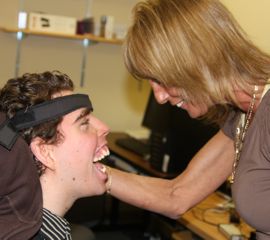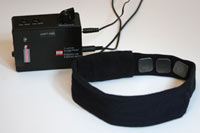Headband-Operated EMG Switch


Over the years, CanAssist has worked with many people living with disabilities for whom communication is enormously challenging.
Frequently, these clients have cerebral palsy, Amyotrophic Lateral Sclerosis (ALS) or other acute conditions that make it difficult for them to speak clearly, use their limbs, and sometimes even nod or shake their heads. At times, the only area of their bodies that they can consciously control are some of their facial muscles.
“It is a fortunate evolutionary quirk that people with various advanced neurological conditions retain control over several specific facial muscles for up to 10 or 15 years after losing control over every other muscle group in their body,” says Bill Hook, CanAssist's Manager of Research Projects.
“Sometimes it is only facial muscles that can be controlled by stroke victims or people with various congenital abnormalities.”
In response to requests from such clients or their caregivers, CanAssist has designed a system called the Headband-Operated Switch, which helps people to communicate by contracting the muscles in their face.
The device uses a technique called electromyography (EMG), which evaluates electrical signals associated with the tiniest of muscle movements. Clients are fitted with a special headband lined with surface electrodes that pick up these electrical signals when facial muscles contract. The headband is then attached to an EMG unit that processes the signals. If the signals exceed a pre-set threshold, an electronic switch is activated. This switch can be used to control a range of peripheral devices, such as a voice feedback system, household appliances, computers and even iPods.
For example, an add-on to this technology called the Headband-Operated Switch with Mouse Click Box allows people who are unable to use a keyboard to interact with a computer. This technology is being used for various work, educational and recreational purposes. One teen in Delta, B.C., for instance, is using the Mouse Click Box to take photos with a webcam and to use PowerPoint software for her schooling.
In another setting, a girl from Agassiz is using two customized adaptations of the technology to read electronic books and to write independently. Please see the Switch-Activated Writing System for more details.
A popular CanAssist device, called the Adapted iPod System, can be controlled by using the EMG to control the functions of Apple's ubiquitous iPod nano.
In recent years, CanAssist has shipped systems to clients in Canada, the United States and Sweden. CanAssist researchers continue to work on this exciting technology, creating new applications to help people communicate and participate more fully in society.
(Many clients continue to benefit from this technology, which was first delivered in February 2009.)
